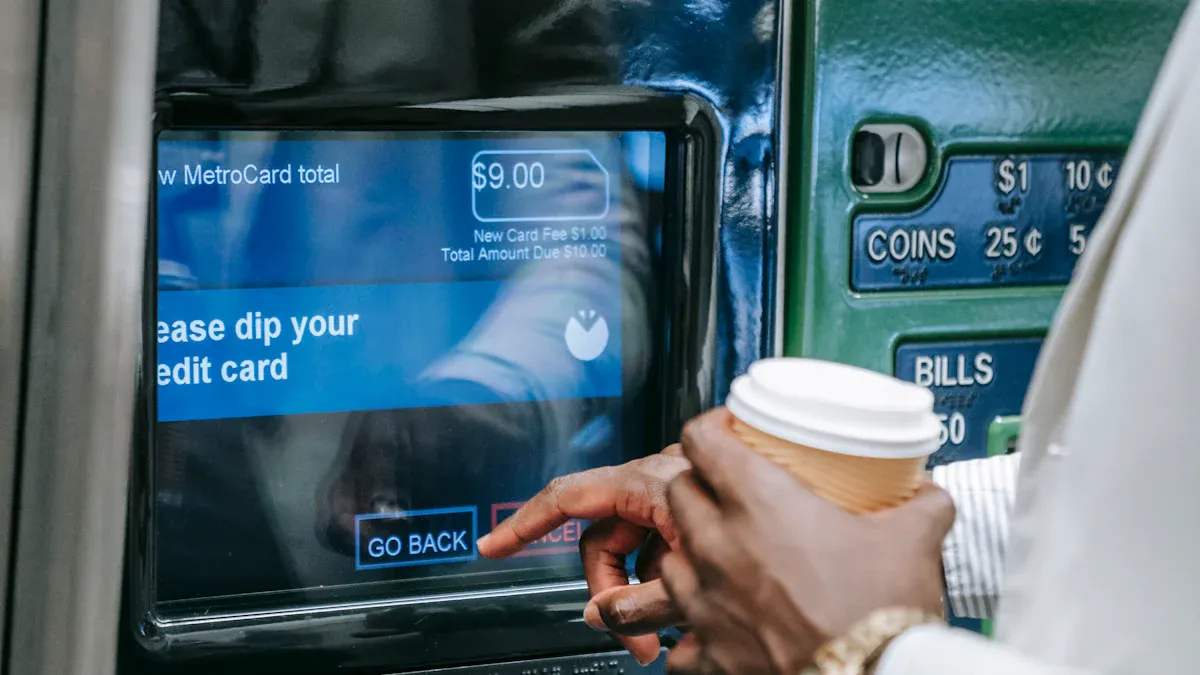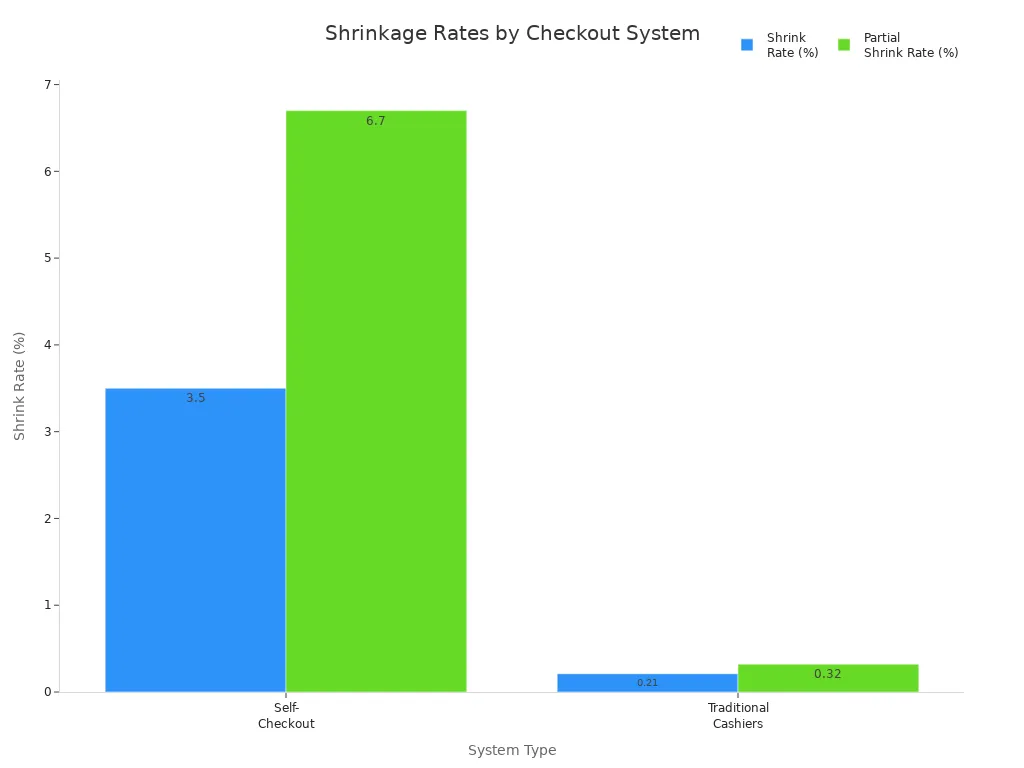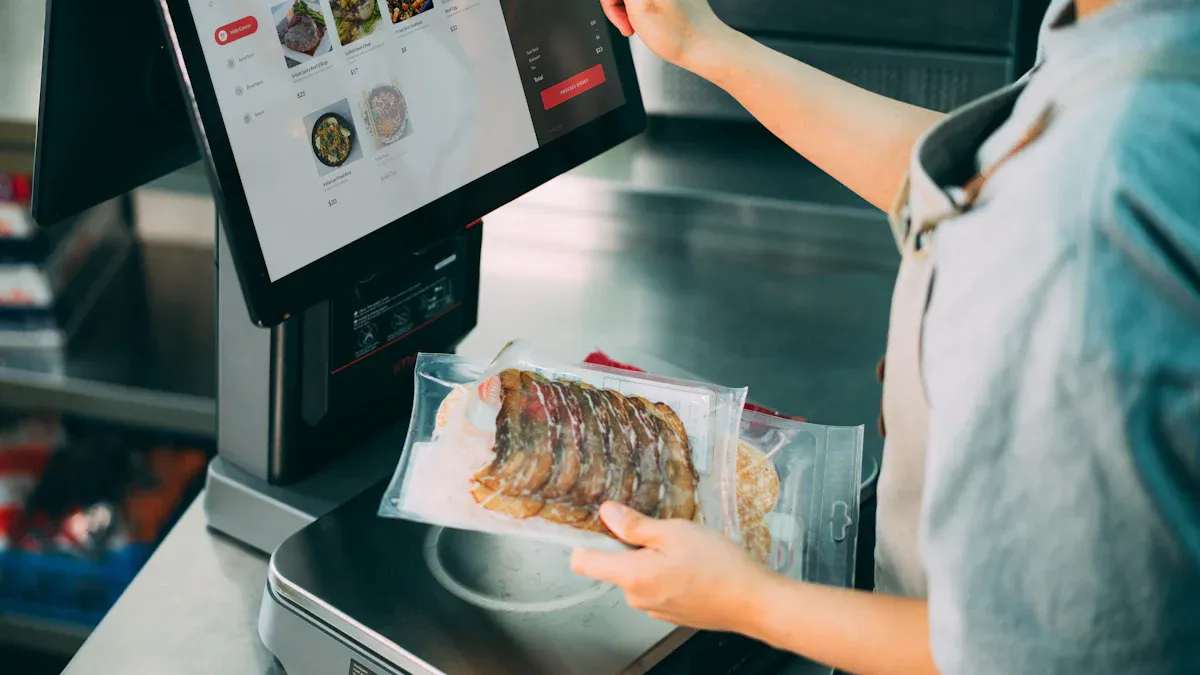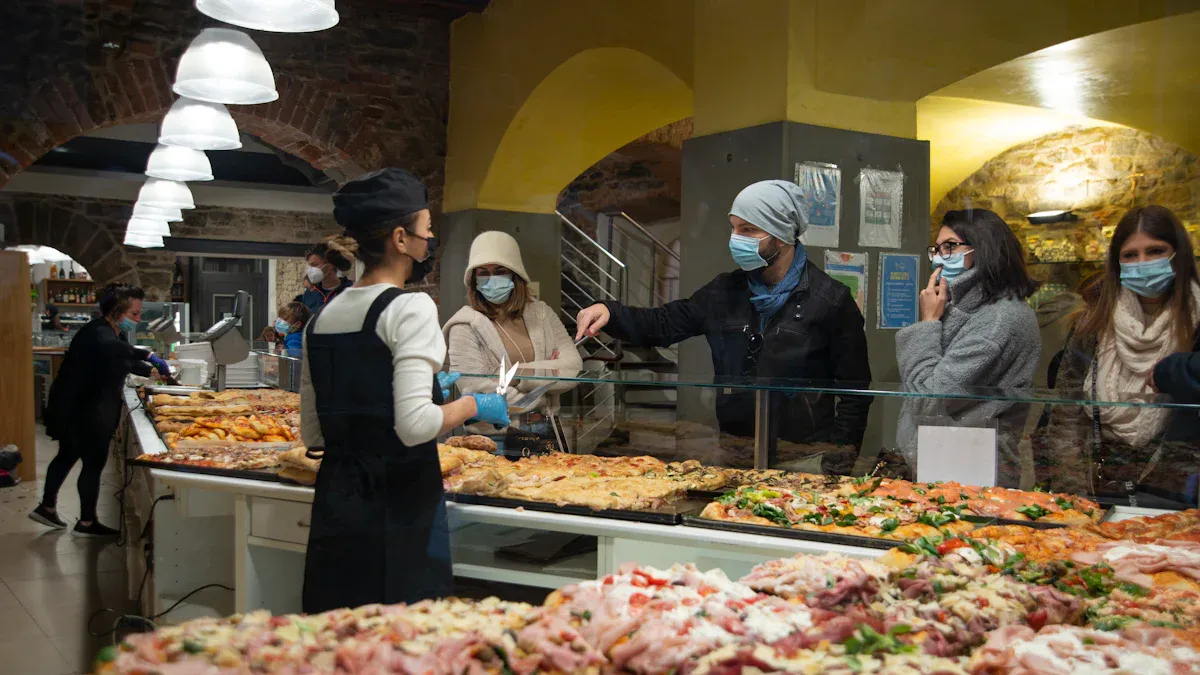AI Self Checkout and Traditional Cashiers: A Side-by-Side Comparison

Retail shoppers want quick, easy, and flexible ways to pay. Many now choose ai powered self checkout for fast trips, while others feel more comfortable with traditional cashiers. More than half of U.S. shoppers say they like self-checkouts for convenience, especially younger buyers. For bigger baskets or when help is needed, people often stick with a cashier. Factors like speed, cost, and how much help a customer wants all play a role in this choice.
Key Takeaways
AI self-checkout makes transactions faster by about 30%. This helps customers with small baskets shop quicker.
Stores can spend less money on workers with self-checkout. Fewer staff are needed to watch many lanes.
People like different things. Younger shoppers often pick self-checkout. Other people like talking to cashiers.
Self-checkout can cause more theft or mistakes. Stores need good ways to stop loss.
Hybrid models use both self-checkout and cashiers. This gives shoppers more choices. It helps everyone feel happier with shopping.
Quick Comparison
Key Differences
Retailers notice big changes when they use ai powered self checkout instead of traditional cashiers. The biggest changes are in how fast people pay, how much stores spend on workers, and how much control shoppers get.
Speed: Self-checkout makes paying about 30% faster than using a cashier. Shoppers scan and pay for their own items. This means lines move quicker.
Cost: Stores spend less on workers because one person can watch many self-checkout lanes. Traditional cashiers need more workers at each register.
Customer Preference: Most shoppers like self-checkout, especially younger people. Some still want a cashier for help or big shopping trips.
Shrinkage (Loss from Theft or Errors): Self-checkout has more loss from theft or mistakes than cashier lanes. Stores must save money but also watch for loss.
Staff Impact: Self-checkout lets stores move workers to other jobs, like stocking shelves or helping customers. There may be fewer cashier jobs, but new jobs can open.
Pros and Cons
Let’s see the main pros and cons for each checkout type. The table below shows the differences in speed, cost, what shoppers like, shrinkage, and staff changes.
Feature | AI Self Checkout | Traditional Cashier |
|---|---|---|
Speed | 30% faster transactions | Standard transaction speed |
Labor Cost | Higher, more staff needed per lane | |
Customer Preference | 77% prefer self-checkout (NCR Voyix) | 23% prefer cashier |
Shrinkage Rate | 0.21% - 0.32% | |
Staff Impact | 40% fewer checkout staff, new roles | Stable cashier jobs |
Tip: Stores with ai powered self checkout often have faster lines and happier shoppers, but they need to watch for more loss.
Customer Preference Table
Source | Percentage of Customers Preferring Self-Checkout |
|---|---|
NCR Voyix | 77% |
NCR Voyix (18-44 age) | >50% |
General Survey | 62% |
Labor Cost Table
System Type | Labor Cost Implications |
|---|---|
Self-Checkout | Cuts labor costs since one worker can watch many lanes; savings depend on store size and layout. |
Needs staff to watch for theft and fix problems, which can raise costs. | |
Traditional Cashier | Needs more workers but may have less hidden costs from theft and repairs. |
Labor savings depend on how the store works and what shoppers do. |
Shrinkage Rate Table
System Type | Shrink Rate (%) | Partial Shrink Rate (%) |
|---|---|---|
Self-Checkout | 3.5 | 6.7 |
Traditional Cashiers | 0.21 | 0.32 |

Staff Impact
Self-checkout kiosks mean stores need fewer cashiers during busy times.
Stores can move workers to other jobs, like restocking or helping shoppers.
Research shows theft can go up by as much as 65% at self-checkout compared to cashier lanes.
Cashier jobs in the U.S. might drop by 10.6% by 2033.
Note: Self-checkout helps stores work better, but staff must learn to fix problems and watch for theft.
AI Powered Self Checkout

System Flow
Ai powered self checkout uses smart tools to help people pay fast. Machine learning and computer vision help watch what happens at checkout. Cameras and sensors follow each item as shoppers scan them. The system checks if the barcode matches the right product. It also looks for mistakes or missed items.
Stores use deep learning and computer vision to make checkout better. Some systems use YOLO, which finds products quickly as you scan. Others use MidState-YOLO-ED, which helps the system spot items even better. The table below lists some machine learning methods used in ai powered self checkout.
Technique | Description |
|---|---|
Deep Learning (DL) | Uses neural networks to handle and analyze visual data with high accuracy. |
Computer Vision (CV) | Helps machines understand images and video from the checkout area. |
YOLO | Detects objects quickly and accurately during the scanning process. |
MidState-YOLO-ED | Uses new ideas from YOLOv10 to boost product recognition in self checkout. |
The system also watches how shoppers move their hands. If someone tries to skip scanning, it can spot this and tell staff. It flags sales for review if something seems wrong, like a barcode not matching the item. Cameras help catch missed scans and stop unpaid items from leaving. Some advanced systems can find fraud with up to 99% accuracy.
Benefits
Ai powered self checkout gives many good things to stores and shoppers. The biggest plus is speed. Shoppers can pay about 30% faster than with a cashier. This means lines are shorter and people wait less, even when it’s busy. Many people like self checkout for quick trips, and 43% say they pick it for faster service.
Stores have fewer checkout problems because the system finds errors and tells staff right away. At Lowe’s, shoppers say lines are shorter and they need less help from workers. Ai powered self checkout also makes shopping feel more personal. The system can guess what a shopper likes and offer special deals. It uses data from both in-store and online shopping to give offers just for you.
Retail leaders say ai powered self checkout has made checkout more accurate and faster. About 75% think these systems make checkout smoother. Shoppers see fewer mistakes and a faster process, so they are happier.
Another big plus is less shrinkage. Ai powered self checkout uses computer vision to watch sales as they happen. It finds errors and warns staff about anything odd. This helps stop theft and fixes mistakes before they get worse. More stores are spending money on tech to fight shrinkage, with 52% raising their budgets for these tools.
Tip: Ai powered self checkout can help stores save money, make shoppers happier, and lower loss from theft or mistakes.
Challenges
Stores have some hard problems with ai powered self checkout. The system sometimes can’t tell similar products apart, especially if they look alike. It needs lots of training data to get better at this.
Processing all the camera and sensor data in real time needs strong computers. Stores must have good IT systems to do this. Connecting ai powered self checkout to other store systems can be hard and may need new software or hardware.
Stores change often, so the system must keep learning to stay correct. It’s also tough to study how different shoppers act. The system needs smart programs to understand what people do at checkout.
Here are some common problems:
Telling similar products apart.
Handling real-time data and analysis.
Connecting with current store systems.
Adapting to changing store conditions.
Studying complex shopper actions.
Challenge Type | Description |
|---|---|
Product Recognition | Hard to tell similar items apart; needs lots of training data. |
Real-Time Processing | Needs strong computers to analyze data quickly for many customers. |
System Integration | Must connect with current store systems, which can be complex. |
Dynamic Environment | Store conditions change often, so the system must keep learning. |
Customer Behavior Analysis | Hard to understand all the ways customers interact with the system. |
Note: Stores should plan for these problems when setting up ai powered self checkout. Good training and strong support can help the system work better.
Traditional Cashiers

Process Overview
Traditional cashiers have a set routine each day. They first check the cash drawer and make sure the starting money is correct. During their shift, they scan items, take payments, and give back change. Cashiers keep the drawer safe and do cash drops to lower risk. At the end of the day, they count the money and check it against sales records. If there are mistakes, they fix them. They finish by locking up the money and signing off on the totals.
Typical steps for a cashier:
Check the starting cash and set up the drawer.
Handle sales and keep the drawer safe.
Do cash drops when it gets busy.
Count cash at the end and check records.
Fix mistakes and write down the final amount.
Strengths
Traditional cashiers have many good points that shoppers notice. They greet people and make the store feel friendly. Many shoppers like talking to a cashier, especially if they need help. Cashiers can see problems and fix them fast. They follow store rules and keep sales safe.
Strengths of Traditional Cashiers | Evidence from Customer Feedback and Operational Data |
|---|---|
Personalized Customer Experience | Cashiers can make shopping fun in ways machines cannot. |
Effective Communication Skills | AI can study body language and voice to check service. |
Adherence to Store Policies | Watching how cashiers handle money keeps service steady. |
Positive Shopping Environment | Cashiers help make the store welcoming, which makes shoppers happy. |
Good feedback from shoppers helps cashiers feel proud.
Helpful advice leads to better training and service.
Stores with happy cashiers often have more satisfied shoppers.
Tip: Cashiers make shopping feel special and help shoppers trust the store.
Limitations
Cashiers have some problems in stores today. Stores pay more for wages, benefits, and training for cashiers. About one third of the budget goes to staff. Lines can get long and slow, especially when it is busy. Cashiers may need extra lessons to learn new tech.
Stores pay more for cashier wages and benefits.
A big part of the budget goes to cashier staff.
Note: Cashiers give great service, but stores must watch costs and speed to keep up.
Customer Experience
Convenience
Shoppers want checkout to be fast and simple. Many use self-checkout for small baskets because it saves time. People with just a few things finish faster at these machines. A survey showed 77% of shoppers like self-checkout for its speed. They enjoy leaving the store quickly without waiting. For bigger shopping trips, cashier lanes work better. Cashiers scan items fast and handle large orders with fewer mistakes. How easy checkout feels depends on how much you buy and if you need help.
Self-checkout is quicker for small baskets.
Most shoppers choose self-checkout for speed.
Cashier lanes are better for big orders and make checkout easier.
Support & Error Handling
Help is important when problems happen. Self-checkout gives shoppers more control and shorter waits, especially when it’s busy. People like scanning and paying by themselves. Sometimes, machines break or do not scan items right. These problems can make shoppers upset. When self-checkout does not work, many go back to cashiers for help. Cashiers fix mistakes quickly and answer questions. Stores need to balance speed and good service so shoppers stay happy.
Self-checkout lets people shop alone and finish fast.
Some people find the machines hard to use, which can be frustrating.
Machine errors often make shoppers use cashiers again.
Findings | Description |
|---|---|
Positive Effects | Self-checkout helps people buy private things, like condoms, without feeling embarrassed. |
Customer Willingness | Shoppers will spend more time at self-checkout for privacy when buying sensitive products. |
Accessibility
Not every shopper thinks checkout is easy. People with disabilities have trouble at self-checkout. Some screens are hard to see, and buttons can be confusing. Josh Boykin, who has low vision, shared online that self-checkout screens make shopping hard. He had trouble following directions and seeing the LCD display. As stores add more kiosks, these problems get worse.
Target is starting a new self-checkout system for people with disabilities. It has Braille, high-contrast buttons, a headphone jack, and a controller you can feel. Blind shoppers gave feedback to help design it. These features also help people with motor disabilities.
Some shoppers with disabilities find self-checkout screens hard to use.
Cashiers can help people who need extra support.
New technology tries to make self-checkout easier for everyone.
Staff & Operations
Role Changes
When stores add AI self checkout, staff jobs change. Workers do not scan as many items as before. They help shoppers when machines are confusing or break. Staff also watch for theft and fraud, which can be stressful. Some workers get upset when customers are mad about self-checkout problems. But AI systems let staff focus on helping people and solving real problems. This means workers can use their skills in new ways.
Staff answer more questions about self-checkout.
Workers watch for theft and fraud at kiosks.
AI makes checkout smoother and less stressful.
Employees spend more time helping shoppers.
Training Needs
Stores must teach staff how to use AI self checkout. Regular lessons help everyone learn new features and privacy rules. Workers learn to keep customer data safe and follow store rules. AI tools let staff practice real-life problems, so they know what to do. Ongoing lessons help workers feel ready for new technology.
Staff need regular lessons on AI and privacy.
AI gives practice for customer service problems.
More lessons help workers stay skilled and ready.
Tip: Stores that train staff well have fewer mistakes and happier workers.
Employee Impact
AI self checkout changes how workers feel at their jobs. Many say they feel less stress because there are fewer complaints. They can help shoppers who really need support. Some workers get new jobs, like self-checkout coaches, and learn new skills. The table below shows how AI self checkout changes job happiness and stress.
Impact Type | Description |
|---|---|
😊 Reduced Stress | Workers deal with fewer problems, so they feel happier. |
🤝 Enhanced Support | Staff help real customer needs, making work better. |
🚀 Development | Workers get new jobs and skills, which helps their careers. |
Note: When stores use AI self checkout, workers often feel better about their jobs and find new ways to do well.
Cost Analysis
Initial Investment
Stores have to make big choices about checkout systems. AI self checkout kiosks cost a lot at first. One kiosk costs about $30,000. If a store wants four lanes, it pays around $125,000. Traditional cashier setups need less money to start. The price depends on how many registers and how big the store is.
System Type | Average Cost |
|---|---|
Self-Checkout Kiosk | $30,000 |
Four-Lane Kiosk Setup | $125,000 |
🏪 Stores pay more for extra lanes, but they can help more shoppers at once.
Ongoing Costs
AI self checkout needs regular care and fixing. Maintenance and tech support cost more than with cashiers. Stores must teach workers to use the machines and watch for theft. Labor costs go down because fewer people run the area. Stores spend more to stop loss, so loss prevention is very important.
Cost Category | AI Self-Checkout Systems | Traditional Cashier Systems |
|---|---|---|
Maintenance Costs | Lower | |
Technical Support Costs | Higher | Lower |
Labor Costs | Reduced | Higher |
Loss Prevention Requirements | Increased | Standard |
Staff Training for Management | Required | Not Required |
AI systems need more tech help and updates.
Cashier systems cost more in pay but less in repairs.
ROI
Stores want to know if they save money in the end. AI self checkout saves on labor over time. Customer lines move faster after staff learn the system. Shrinkage goes up with self checkout, so stores must work hard to stop loss. Some shoppers like the speed, but others miss talking to cashiers.
Metric | Self-Checkout | Staffed Checkout |
|---|---|---|
Labor Cost Savings | High | Low |
Theft/Shrinkage Rate | <1% | |
Customer Throughput | Fast (with training) | Moderate |
Customer Satisfaction | Mixed | High (for service) |
💡 Stores that train workers well and use good security get better results with AI self checkout.
Challenges & Solutions
Technical Issues
Retailers have some big problems with ai powered self checkout. Shoppers often have trouble with fresh produce. The system asks them to pick the right fruit or vegetable. People sometimes pick the wrong kind, like the wrong apple. Store workers need to help with produce lookup, which slows down the line and makes shoppers upset. Some stores use different machines that do not work together. This makes checkout harder and causes more mistakes. Staff often have to step in when the system cannot find an item or when scales do not connect. Workers spend more time fixing these problems, so their jobs get harder.
Fresh produce needs workers to help shoppers.
Different machines make checkout harder.
Staff must help a lot, so lines get longer.
Security
Security is a big worry for stores and shoppers. Self-checkout lanes can have more theft and mistakes. Stores use cameras and sensors to watch for problems, but some spots are not covered. If the system does not track items well, things can leave the store without being paid for. Stores teach workers to watch kiosks and help if something looks wrong. AI systems spot strange actions and tell staff fast. This helps stop theft and keeps stores from losing money.
Tip: Stores do better at stopping theft when they use both technology and staff to watch self-checkout.
Adoption
Getting shoppers to use ai powered self checkout takes work. Stores that show people how to use the machines see more shoppers try them. Signs, easy guides, and short demos near the checkout help a lot. Workers who answer questions and help with problems make shoppers want to use self-checkout. Stores test new systems with pilot programs and ask for feedback before using them everywhere. When stores add new tech and train workers, shoppers feel safer and more ready to use it.
Teaching shoppers helps more people use self-checkout.
Demos and guides make learning easier.
Staff help and pilot tests make change smoother.
Note: Cashiers feel less stress when self-checkout lets them do other jobs, like stocking shelves or helping with drinks. They stay busy and feel good about their work, even as their jobs change.
Recommendations
Small Business Fit
Small stores face tight budgets and want easy solutions. Owners often know their customers by name. They value personal service and quick fixes. Traditional cashiers work well in these shops. Cashiers greet shoppers and help with questions. They spot problems fast and keep checkout smooth. AI self checkout can help if the store has many young shoppers or wants to save on labor. Owners should test one kiosk before buying more.
Best for small businesses:
Stores with loyal customers
Shops with fewer than 5 checkout lanes
Owners who want personal service
Tip: Small shops can try a single self-checkout kiosk during busy hours. They should watch how customers react before making big changes.
Large Retailer Fit
Big stores need speed and lower costs. They see hundreds of shoppers every hour. AI self checkout works well in these places. It moves lines faster and cuts labor costs. Staff can help with problems and watch for theft. Large retailers often use many kiosks and train workers to help shoppers. They also use cameras and sensors to stop loss.
Store Type | Best Checkout Option | Key Benefit |
|---|---|---|
Supermarkets | AI Self Checkout | Fast lines |
Department | AI Self Checkout + Staff | Lower costs |
Warehouse | Hybrid | Flexibility |
Note: Large retailers should invest in strong training and security. They can mix self checkout with staffed lanes for best results.
Hybrid Models
Some stores use both systems. Hybrid models give shoppers a choice. People with small baskets use self checkout. Shoppers with big orders or special needs go to cashiers. Staff help at both types of lanes. This model works in stores of any size.
Hybrid model benefits:
Flexibility for all shoppers
Lower wait times
Better customer satisfaction
Stores can start with a few self checkout kiosks and keep some cashier lanes. They should ask for feedback and adjust as needed.
Retailers pick checkout systems by looking at their store size and what customers want. AI self checkout is good for busy stores that need faster lines and want to spend less money. Traditional cashiers are better for shops where friendly service is important. Many stores use both types so all shoppers are happy. Experts think there could be 2 million self-checkout terminals by 2029. As technology gets better, cashierless checkouts might become normal, but hybrid models will still be popular for people who like having choices.
FAQ
What makes AI self checkout faster than a cashier?
AI self checkout lets shoppers scan and pay for items themselves. The system uses smart cameras and sensors to speed up the process. People finish shopping quicker, especially with small baskets.
Do stores save money with AI self checkout?
Stores often save on labor costs because fewer staff watch more lanes. They spend more on machines and tech support. Over time, many retailers see lower costs and faster service.
Can shoppers get help if the self checkout breaks?
Staff stay nearby to help with problems. If a machine stops working or an item will not scan, workers step in. Shoppers can always ask for help at the kiosk.
Is self checkout safe for personal information?
Stores use strong security to protect shopper data. AI systems follow privacy rules and keep information safe. Shoppers should check for privacy signs and ask staff if they have questions.
See Also
Navigating Walgreens Self-Checkout: Benefits And Hurdles In Shopping
The Progression Of Self-Checkout Technology Over Time
Addressing Self-Checkout Cash Mistakes: Reasons And Remedies
Discovering How Cloudpick Introduces Cashier-Free Shopping Experience
